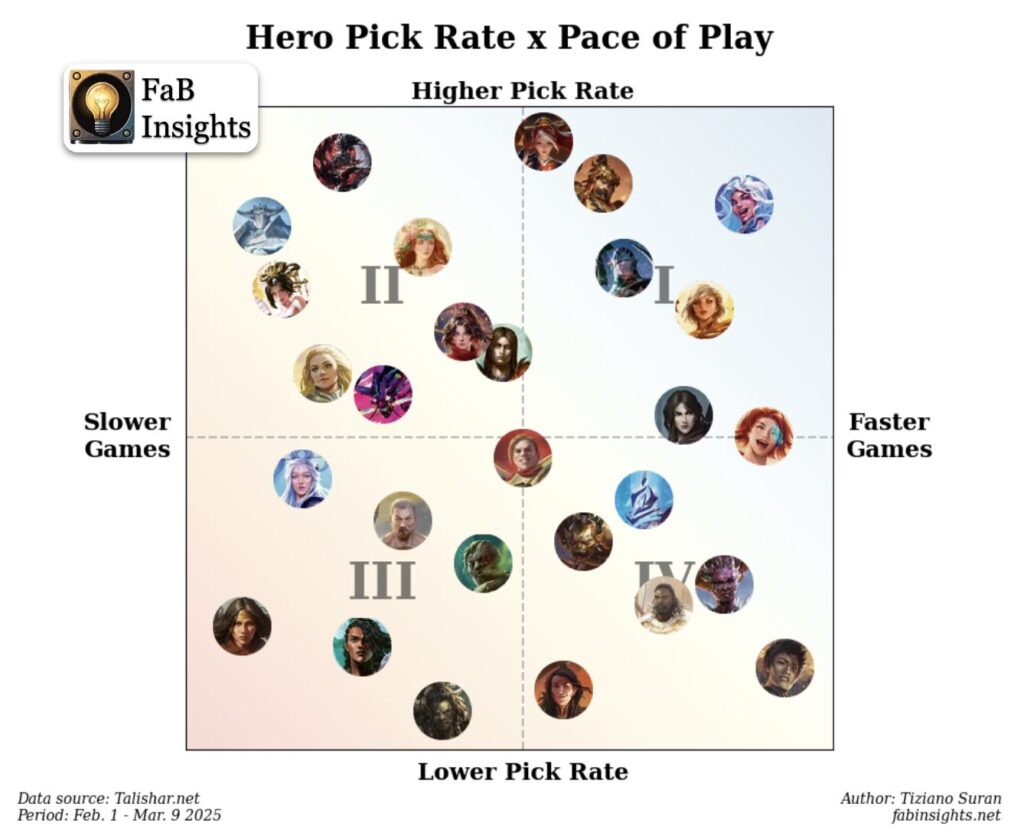Understanding the balance between aggressive and control-oriented strategies is crucial in Flesh and Blood. Some heroes look to close out games quickly, while others aim for long, grindy battles. To visualize these trends, I’ve analyzed over 100,000 Talishar matches since the start of February, plotting hero pick rate against pace of play (measured by match duration).
The result is a scatterplot that divides heroes into four quadrants, each representing a distinct approach to the game. Let’s break down what these quadrants mean and highlight some key heroes within each.
Note on the Data
To ensure meaningful analysis, I filtered the dataset to include only games that lasted between 10 and 50 minutes and had at least four turns, removing outliers such as prematurely conceded matches or excessively long control mirrors. Additionally, the scatterplot presents relative values rather than absolute ones—each hero’s pick rate and pace of play are ranked within their respective distributions. This means the chart highlights how heroes compare to one another in the current meta rather than providing direct numerical measurements of their exact speed or popularity.

Quadrant I: High-Speed, High-Pick Rate (Fast Aggro) ⚡
These heroes play aggressively and see frequent play, indicating that the meta favors fast-paced strategies.
- Cindra continues to dominate as the most-played hero, leveraging explosive power to win quickly.
- Aurora and Prism both see high pick rates with fast game speeds, suggesting that light-based strategies are thriving in the current environment.
- Dash I/O and Fang also stand out as popular, quick-hitting heroes.
Quadrant II: Slow-Paced, High-Pick Rate (Control Staples) 🛡️
These heroes opt for endurance, favoring long games and resourceful play.
- Jarl Vetreiđi may have fallen in pick rate rankings, but he remains a defining control hero with the slowest average match speed.
- Arakni, Marionette and Verdance both feature strong defensive elements and see steady play.
- Dorinthea Ironsong continues to appeal to players who prefer reactive, calculated strategies.
Quadrant III: Slow-Paced, Lower-Pick Rate (Niche Control) 🌀
These heroes favor a control-heavy playstyle but have lower representation in the meta.
- Kassai and Enigma are among the slowest heroes, often requiring specific conditions to shine.
- Riptide leans into patient, trap-based strategies, keeping him on the fringe of competitive play.
- Zen currenlty does not mind defending until he’s found his right moment to return the favors.
Quadrant IV: High-Speed, Lower-Pick Rate (Underrated Aggro) 🔥
These heroes aim for speed but aren’t as widely played, making them potential sleeper picks.
- Fai and Kano (in his apparently current most popular version) both play at breakneck speed but have lower pick rates, possibly due to their demanding execution.
- Levia, Boltyn and Kayo are fast but currently overshadowed by more popular aggressive options.
Final Thoughts
The aggro-control spectrum provides valuable insight into how different heroes shape the pace of online games. Aggressive powerhouses like Cindra, Aurora, and Fang dictate fast, proactive play, while Jarl, Verdance, Arakni variants and Nuu thrive in drawn-out, methodical battles. Meanwhile, heroes like Fai show that speed doesn’t always correlate with popularity—despite being one of the fastest heroes, his pick rate remains relatively low, but in the right hands can still shine.
As the online meta evolves, tracking these trends will be crucial for understanding shifts in strategy and deckbuilding. Whether you prefer to burn down opponents in minutes or grind them out over time, knowing where heroes fall on this spectrum can help you anticipate matchups and refine your game plan.
If you found this analysis insightful, consider supporting my work on Patreon—your support helps me continue providing in-depth breakdowns and strategic insights for the Flesh and Blood community!



